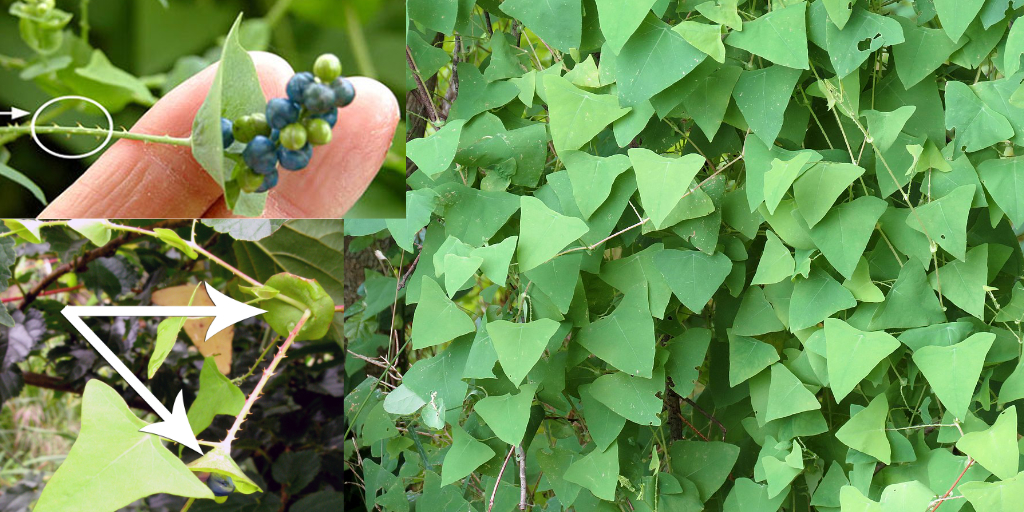MELeaf: A Newsletter From the Horticulture Program, September 6, 2023
In this issue:
Early in August, DACF confirmed the invasive plant mile-a-minute vine (Persicaria perfoliata, MAM) in Maine for the first time. Since then, we have confirmed MAM at two additional sites. Mile-a-minute is an aggressive grower that can quickly grow over plants, smothering them with its dense foliage. Due to the size and age of the MAM plants, we believe that the MAM was newly growing at all three sites, and we consider these finds, interceptions, rather than established populations. All MAM plants to date have been removed and we will continue monitoring the sites and removing any additional MAM plants that may grow.
MAM is known to hitchhike with nursery stock and one interception in Maine was self-reported by a garden center that identified the MAM growing in the rootballs of plant material they had received from out-of-state; the two other findings were also associated with newly installed plantings. MAM is on Maine’s Do Not Sell Invasive Plant List and a stop-sale order would be issued if we observed it growing as a weed in a pot or rootball. Inspect the rootballs of any incoming plants to prevent unintentionally spreading this problematic plant, looking carefully for vining weeds.
Characteristics of MAM to look for include:
-
Triangular leaves that are not lobed at the base.
- Strong, sharp prickles along the stem that easily scratch an ungloved hand.
-
Clasping leaf-like structures at the leaf base and flower stems.
 Mile-a-minute vine. Circled are the recurved prickles (top left), the arrows point to the ocrea, which are circular leaf-like structures along the stem (bottom left), triangular shaped dense foliage (right)
Each October, the Maine Board of Pesticides Control and the Maine Department of Environmental Protection conduct a program to collect and safely dispose of obsolete pesticides at four sites across the state (Presque Isle, Bangor, Augusta and Portland). Now is the time to inventory any pesticides you may be storing and protect Maine’s plants, animals and people by properly disposing of any old or unusable pesticides. Banned chemicals, like Chlorpyrifos (Lorsban, Dursban), are also accepted.
General observations - Most of the pests we’ve observed during inspections are primarily weather-related – lots and lots of fungal and bacterial leaf spots on many different plants. In most cases, the damage has been mainly cosmetic and the plant's overall health is likely not in danger. Powdery mildew on various plants, including magnolia, roses, phlox and monarda, are also common, but that is relatively normal for this time of year (and those plants!).
Box tree moth - The last MELeaf featured an article about box tree moth. In addition to the previously reported populations in New York, Michigan and Ohio, box tree moth was recently found in Massachusetts. In Canada, box tree moth is also established in Ontario with recent interceptions at several retail locations in Quebec, New Brunswick, Nova Scotia, Prince Edward Island, and Newfoundland and Labrador. Continue to check any boxwood plants closely for signs of this pest and report any suspicious caterpillars or moths by taking a picture and sending it to the Horticulture Program. Confusingly, sometimes box tree moth gets abbreviated as BTM, which in Maine is commonly used to abbreviate browntail moth. In the Horticulture Program communications, we will generally use BTM when referring to browntail moth.
 photo 1 (Ian Redding): Box tree moth adult – light morph; photo 2 (Juergen Kottmann): adult – dark morph; photo 3 (Mujezinovic Osman, Faculty of Forestry, bugwood.org): mature caterpillar and your caterpillar feeding damage (“peeling”); photo 4 (Ferenc Lakatos, University of Sopron, bugwood.org): heavy defoliation showing midribs of leaves left behind.
Browntail moth – The new generation of browntail moths began hatching at the beginning of August, and the new tiny caterpillars are now feeding and building their overwintering webs. We have had a couple of conversations with growers lately that illustrate that it is easy to confuse browntail moth with fall webworm this time of year as both build silken nests in which they are feeding. The latest Conditions Report from The Maine Forest Service covers how to tell these two caterpillars apart. The young browntail moth caterpillars that are around now are not likely to cause an itchy rash in most people. However, the hairs from earlier in the season can be quite persistent in the environment and can continue to cause problems during fall clean-up activities like raking leaves. Continue to take precautions to minimize your exposure.
 Spotted lanternfly – As in past years, we’ve received sporadic reports of spotted lanternfly (SLF) sightings in Maine. We follow up on each report when we have enough information to do so. To the best of our knowledge, there are still no established populations of SLF yet in Maine. Given this pest’s abundance to our south and status as a master hitchhiker on vehicles and any outdoor goods, including plants, there are likely multiple introductions of this pest every year that remain unreported, any of which under the right circumstances could lead to an established population. Help slow the spread of SLF now by looking for any suspicious insects. Adult SLFs are present now and will soon be laying eggs. Check any incoming plants carefully. Egg masses can be laid on any item stored outdoors and may be difficult to spot as they closely resemble clumps of mud stuck to the item. Report SLF by sending a picture to the Horticulture Program. Please be sure to include the date and location where the photo was taken.

|